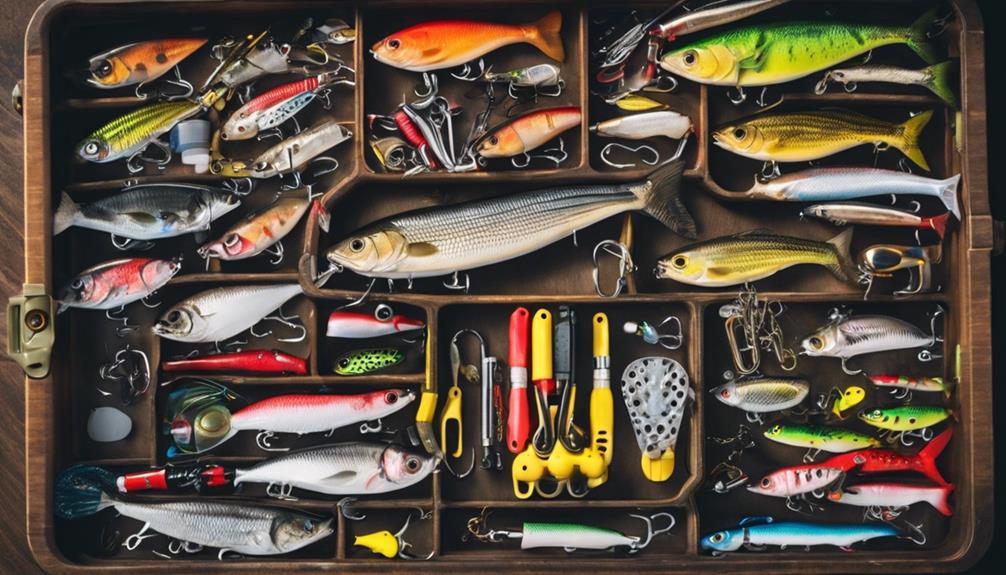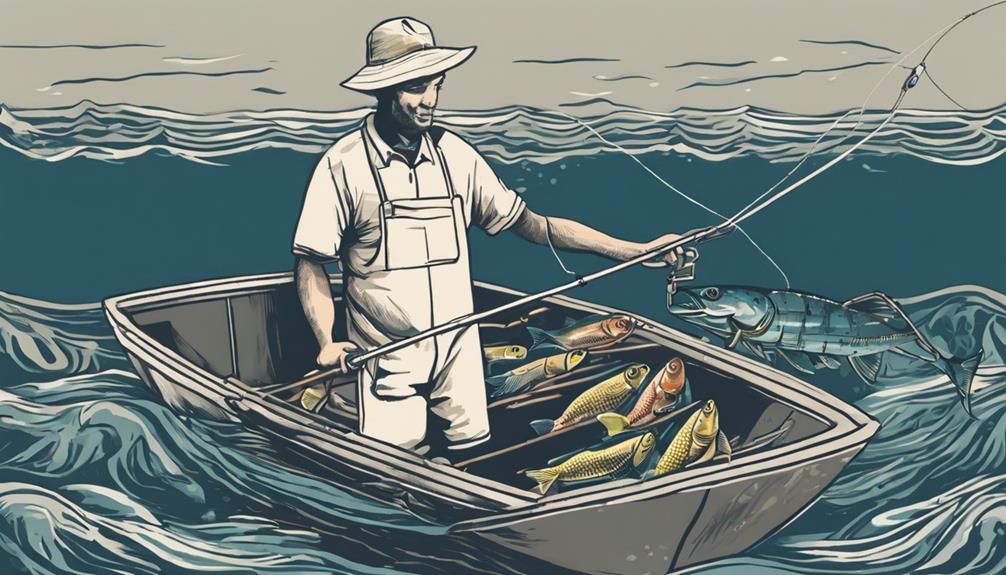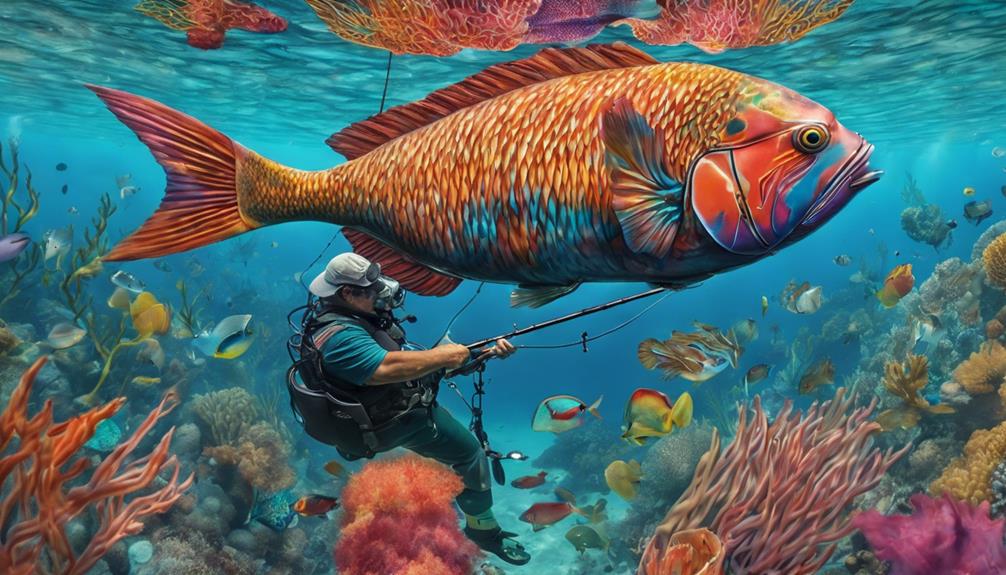Have you ever wondered why some deep-sea anglers seem to consistently reel in specific species while others struggle to get a bite? Understanding the nuances of species-specific deep-sea fishing can significantly improve your chances of a successful catch.
By honing in on the unique characteristics and behaviors of your target species, you can enhance your fishing experience and increase your chances of success.
Stay tuned to discover essential tips that will elevate your deep-sea fishing game to the next level.
Understanding Your Target Species
Before heading out for deep-sea fishing, you must familiarize yourself with the identifying characteristics and behaviors of the specific species you're targeting. Each species has unique traits that can help you determine the best fishing strategies for a successful trip.
Identifying characteristics play a crucial role in deep-sea fishing. For example, if you're targeting tuna, you'll notice their streamlined bodies, metallic blue coloration, and forked tail. These features help tuna swim at high speeds, making them a challenging yet rewarding catch. On the other hand, if you're going after mahi-mahi, you'll recognize their vibrant colors, protruding forehead, and long dorsal fin. Understanding these distinguishing features won't only help you identify the species but also tailor your fishing techniques accordingly.
Fishing strategies vary depending on the species you're targeting. For instance, if you're fishing for swordfish, you may need to use deep drop rigs and fish during the nighttime when swordfish are closer to the surface. Conversely, if you're targeting marlin, you might use artificial lures and troll at varying speeds to attract this elusive predator. By researching and understanding the identifying characteristics and fishing strategies specific to your target species, you can increase your chances of a successful deep-sea fishing adventure.
Researching Habitat and Behavior
To enhance your deep-sea fishing success, delve into researching the habitat and behavior of your target species. Understanding predator-prey dynamics is crucial in predicting where your target species may be located. Predators tend to follow their prey, so knowing the feeding habits and migration patterns of the species you're targeting can significantly increase your chances of a successful catch. By studying the interactions between predators and prey, you can identify prime locations to drop your line.
Environmental impacts play a significant role in the behavior of deep-sea species. Changes in water temperature, currents, and salinity can all influence the movement and feeding patterns of marine life. Researching how environmental factors affect your target species can help you anticipate their behavior on any given day. For example, certain species may be more active during specific times of the year due to environmental changes, making it essential to align your fishing trips accordingly.
Selecting the Right Bait
Researching the preferred food sources of your target species is essential when selecting the right bait for deep-sea fishing. Understanding what your target fish naturally feeds on will significantly increase your chances of a successful catch. Here are some tips to help you with bait selection:
- Study the Species: Take the time to research the specific species you're targeting. Some fish are carnivorous and prefer live bait, while others may be more attracted to artificial lures that mimic their natural prey. Knowing these details will guide your bait selection process.
- Match the Hatch: Consider the size and color of the baitfish or prey that the target species typically feeds on. Matching the hatch by using bait that closely resembles their natural food source can make your presentation more enticing.
- Experiment with Lure Presentation: Once you've selected the right bait, focus on how you present it. Experiment with different retrieval speeds, depths, and movements to mimic the natural behavior of the prey. Sometimes, a simple change in lure presentation can make a significant difference in getting the fish to strike.
Using Proper Fishing Techniques
When utilizing proper fishing techniques at sea, your success greatly hinges on mastering the art of presenting your bait effectively. Perfecting technique is the key to maximizing catch rates in deep-sea fishing. Start by ensuring your bait is rigged correctly. Whether using live bait or lures, the way you set up your gear can make a significant difference in attracting the targeted species. Make sure your knots are secure, and your bait is swimming or moving naturally in the water.
Another crucial aspect of using proper fishing techniques is understanding the behavior of the fish you're targeting. Different species have unique feeding habits and preferences, so adapting your technique to match these behaviors can greatly increase your chances of a successful catch. Researching the specific species you're after can provide valuable insights into the best ways to present your bait.
Additionally, mastering the skill of setting the hook at the right moment is essential. Knowing when to strike can be the difference between a successful catch and a missed opportunity. Practice your timing to ensure you're ready to set the hook swiftly and effectively when you feel a bite.
Adjusting Depth and Speed
Adjusting the depth and speed of your bait can significantly impact your success in deep-sea fishing. To optimize your chances of a good catch, here are some key points to consider:
- Optimal Conditions: Before dropping your line, take the time to assess the current conditions. Different species of fish prefer varying depths and speeds, so knowing what you're targeting is crucial. Use fish finders or research the typical habits of the fish in the area to determine the best depth to set your bait.
- Strategic Planning: Once you've identified the optimal depth, it's time to strategize your approach. Start by setting your bait at different depths to see where the fish are most active. If you're not getting any bites, don't hesitate to adjust the depth and speed accordingly. Sometimes even small changes can make a big difference in attracting the right fish.
- Adaptability: Deep-sea fishing requires flexibility. The conditions can change rapidly, so be prepared to adjust your depth and speed throughout your fishing trip. By staying observant and willing to adapt your strategy, you'll increase your chances of a successful catch.
Being Patient and Observant
To maximize your chances of a successful catch in deep-sea fishing, developing patience and keen observation skills is essential. Practicing mindfulness while out on the water can significantly improve your fishing experience. Take the time to appreciate the vastness of the ocean around you, the sound of the waves, and the movements of seabirds. By being present in the moment, you can better connect with your surroundings and detect subtle changes that may indicate fish activity.
In addition to mindfulness, developing intuition plays a crucial role in deep-sea fishing. Pay close attention to your instincts and gut feelings while out on the water. Sometimes, your intuition can lead you to the perfect spot or help you anticipate when the fish are likely to bite. Trusting your intuition can set you apart as a successful deep-sea angler.
Being patient is another key aspect of deep-sea fishing. Fish don't always bite immediately, so it's important to wait calmly and attentively. Avoid getting frustrated if you don't get a bite right away; instead, use the time to observe the water, the behavior of other sea creatures, and any signs of fish activity. Remember, patience is often rewarded with a great catch.
Maintaining Fishing Equipment

Proper maintenance of your fishing equipment is crucial for ensuring optimal performance and longevity during your deep-sea fishing adventures. To keep your gear in top condition, follow these essential tips:
- Cleaning: After each fishing trip, make sure to clean your fishing equipment thoroughly. Rinse rods, reels, and lines with fresh water to remove salt, sand, and any debris that could cause damage over time. Pay special attention to reels and drag systems, ensuring they're free of any dirt or grime that could affect their functionality.
- Lubricating Equipment: Regularly lubricate moving parts such as reels and hinges to prevent corrosion and ensure smooth operation. Use lubricants specifically designed for fishing equipment to protect against saltwater corrosion. Proper lubrication will also extend the life of your gear and maintain its performance.
- Proper Storage: Store your fishing equipment in a cool, dry place to prevent rust and corrosion. Avoid leaving gear in direct sunlight or damp areas, as this can damage rods, reels, and lines. Consider investing in rod holders or racks to keep your gear organized and protected when not in use.
Respecting Catch Limits and Regulations
Adhering to catch limits and regulations is essential for responsible deep-sea fishing practices. By following catch limits, you contribute to the preservation of fish populations and protect ecosystems from overexploitation. Understanding regulations set by authorities helps maintain a balance in marine environments and ensures sustainable practices for future generations of anglers.
Respecting catch limits isn't just a legal requirement but a moral obligation towards the marine ecosystem. When you adhere to these limits, you help prevent the depletion of fish stocks and maintain the natural balance of the underwater world. Overfishing can have detrimental effects on the food chain and biodiversity, causing long-term damage that may be irreversible.
Protecting ecosystems goes hand in hand with following catch limits. By not exceeding the specified quotas, you allow fish populations to thrive and support the overall health of the ocean. Regulations are put in place to safeguard marine life and habitats, promoting a harmonious relationship between humans and the underwater environment.
To engage in sustainable practices, it's crucial to respect catch limits and adhere to fishing regulations. By doing so, you contribute to the conservation of marine resources and help maintain the delicate balance of the deep-sea ecosystem for the enjoyment of present and future generations.
Frequently Asked Questions
How Can Weather Conditions Impact Deep Sea Fishing for Specific Species?
Weather conditions play a crucial role in deep-sea fishing for specific species. Tides and currents dictate fish behavior and movement.
Moon phases influence feeding patterns, while visibility affects lure effectiveness. Knowing how weather factors impact fish can help you plan successful fishing trips.
Be mindful of these conditions to increase your chances of a fruitful deep-sea fishing adventure.
Are There Any Special Considerations for Deep Sea Fishing at Night for Certain Species?
When fishing at night for specific species, you should consider special equipment selection and nighttime tactics. Opt for glow-in-the-dark lures or LED lights to attract fish.
Use sonar technology to locate schools of fish in the dark. Experiment with different bait options like squid or mackerel for increased success.
Choose the best locations where fish are known to feed at night, such as near underwater structures or reef edges.
What Are Some Common Mistakes to Avoid When Targeting Specific Deep Sea Species?
When targeting specific deep sea species, avoid common mistakes like poor bait selection and not scouting locations carefully. Make sure your tackle is well-maintained and refine your techniques for better results.
How Can One Effectively Handle and Release a Protected Species While Deep Sea Fishing?
When handling and releasing a protected species while deep sea fishing, it's crucial to prioritize conservation. Proper catch handling and release techniques are essential.
Ensure you're gentle when handling the fish, use barbless hooks for easier removal, and avoid causing unnecessary stress.
When releasing the protected species, do so quickly and gently, allowing them to swim away smoothly.
It's important to respect and protect these species to promote marine conservation efforts.
Are There Any Specific Conservation Efforts or Projects Related to Preserving Populations of Certain Deep Sea Species?
To help preserve deep sea species, various conservation initiatives focus on maintaining population sustainability in marine habitats. These projects aim to protect the delicate balance of marine ecosystems by implementing measures such as marine protected areas, sustainable fishing practices, and research on endangered species.
Conclusion
Congratulations on completing the top 8 tips for species-specific deep sea fishing!
By understanding your target species, researching their habitat and behavior, selecting the right bait, and using proper techniques, you're well-equipped for a successful deep sea fishing experience.
Adjusting depth and speed, being patient and observant, maintaining equipment, and respecting catch limits and regulations are also crucial aspects to consider during your fishing trips.
Remember to always stay informed and prepared for your next adventure on the open water!



